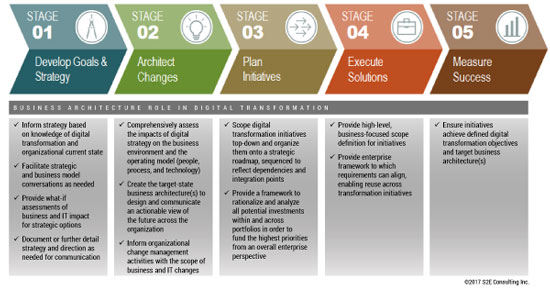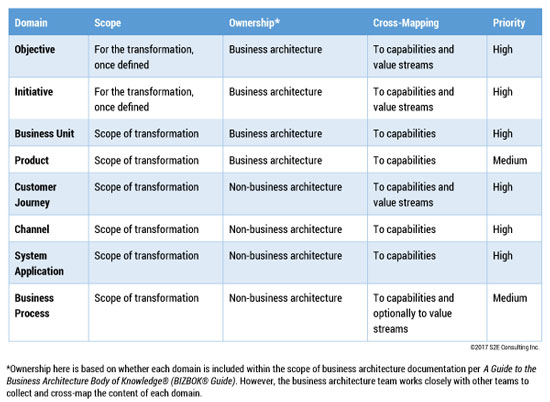Some perceive that business architecture and enterprise architecture do not have a place in digital transformation. These perceptions are typically based on misconceptions, including that the business and technology environment changes too fast for architecture to play a role or that architecture slows or constrains the process of transformation. However, when successfully deployed and business value-focused, a business architecture practice is a critical enabler for digital transformation. Indeed, on the contrary, it is almost impossible to envision designing and executing a digital transformation — or shifting an organization to be continually adaptable to future changes — without a business architecture.
Organizations with a mature practice in place are best positioned to leverage business architecture for enterprise-wide digital transformation. In such cases, a business architecture knowledgebase likely exists, the value and role of business architects during strategy execution is recognized, and a supporting practice to ensure consistency and scale of the discipline has been established. However, since the existence of a mature business architecture practice is fairly rare, it is possible to establish or mature one while leveraging it for digital transformation. Figure 1 outlines the most critical aspects to put into place.

Figure 1 — The role of business architecture in digital transformation across
the strategy execution lifecycle.
Business Architecture Knowledgebase
While it is ideal to have a business architecture knowledgebase that includes content for all domains of the business architecture, the minimum in supporting an enterprise-wide digital transformation includes:
-
Enterprise capability map defined to Level 3 capabilities. If necessary, Level 1 capabilities can be defined for the entire scope of the organization, while Level 3 capabilities can be defined for only those directly impacted by the digital transformation (e.g., customer-facing capabilities).
-
Core value streams. Again, the comprehensive set of all value streams that exist are not required; rather, any internal or external value streams that the digital transformation will impact should be documented, especially the customer-facing ones.
-
Cross-mapping of the capabilities to value stream stages to provide context for capability usage.
Capabilities, value streams, and their cross-mapping provide the foundational business architecture, which is the connection point for the rest of the business architecture as well as the operating model. However, it is also important to document some additional domains (see Table 1). The volume of content and cross-mapping necessary for an enterprise-wide digital transformation usually requires an automated tool to support information capture, analysis, and reporting.

Table 1 — Additional domains to document for digital transformation.
Business Architects and Business Architecture Practice
Leveraging business architecture for a digital transformation not only requires the knowledgebase, but also the business architects who play an invaluable role in informing digital strategy, assessing the impacts, translating the strategy into the future design of the organization, and defining the initiatives required to achieve it. The business architect role must be defined and socialized — and filled with trained and ideally certified (i.e., Certified Business Architect®) individuals who have a range of experience. Though it may continue to mature over time, a supporting practice must also be in place to orchestrate and ensure consistency of activities, such as business architecture training, methodology, governance, and tooling.
[For more from the author on this topic, see “Business Architecture: Critical for Digital Transformation.”]



